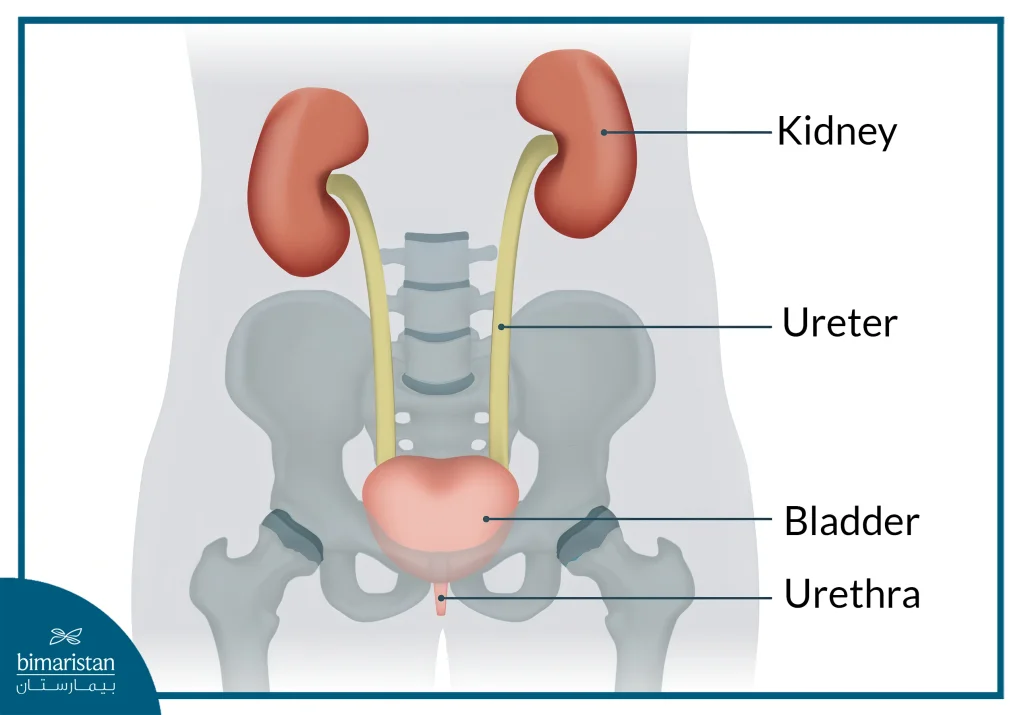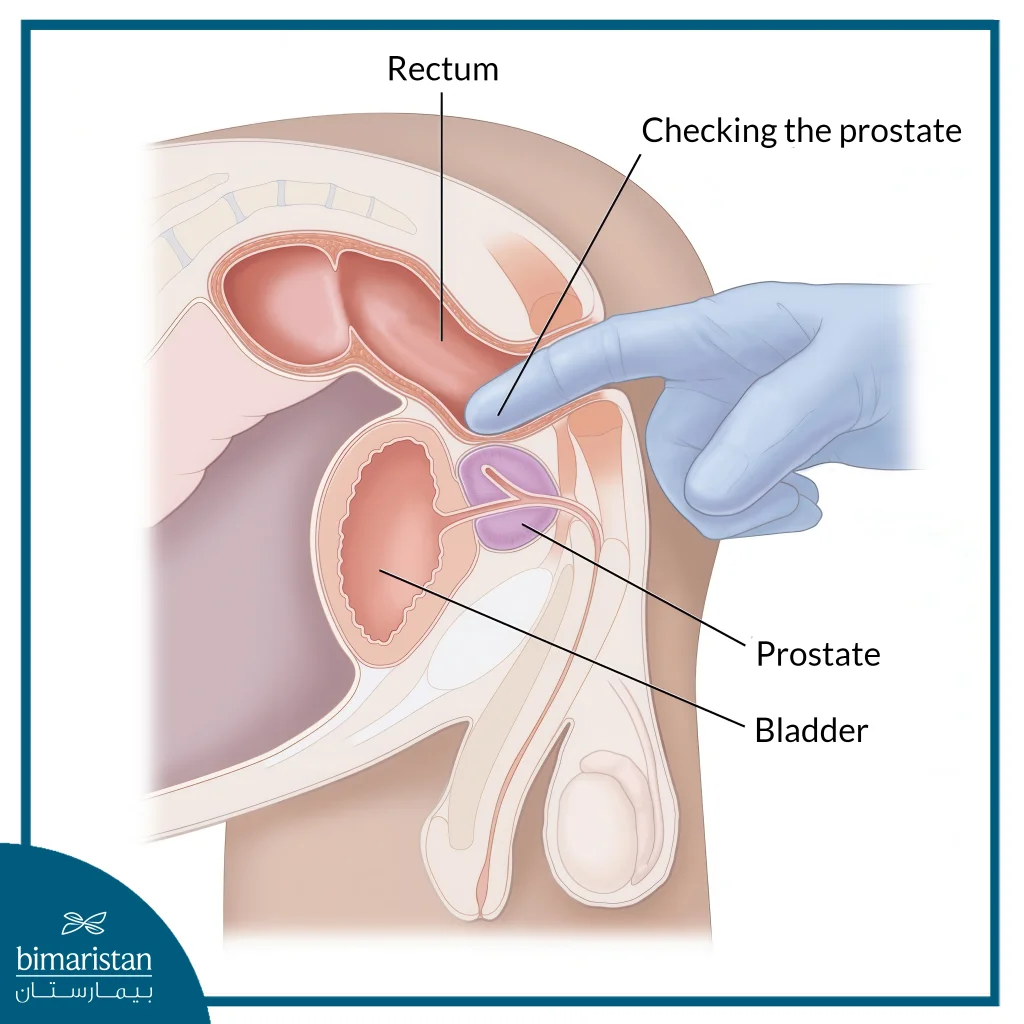A urinary tract infection (UTI) refers to a group of infections that impact different components of the urinary system, including the kidneys, ureters, bladder, and urethra. It ranks among the most prevalent bacterial infections, particularly in women, whereas its occurrence in men is significantly lower and typically linked to aging or underlying chronic conditions.
Urinary tract infection cases range in severity from mild infections that respond swiftly to antibiotic therapy to more serious forms that may progress into kidney infections or lead to critical complications such as sepsis or renal failure. Timely prevention, accurate diagnosis, and prompt treatment are crucial strategies for reducing the impact of urinary tract infections on both health and quality of life.
What are the components of the urinary system?
In order to understand how infections develop within the urinary tract, we need to understand its parts and functions in detail:
- Kidneys: These bean-shaped organs are located at the back of the abdominal cavity. The kidneys filter waste from the blood, regulate the balance of fluids and salts, and form urine.
- Ureters: Two muscular ducts that carry urine from the kidneys to the bladder in peristaltic movements.
- Bladder: A hollow muscular organ located in the pelvis that acts as a storehouse for urine until it’s time to empty.
- Urethra: A tube that carries urine from the bladder to the outside of the body. Its length differs between males and females, as it is shorter in women, making it easier for bacteria to travel to the bladder.
The urinary system maintains a sterile environment in a normal state thanks to a constant flow of urine, proper acidity, and internal immune factors.

Types of urinary tract infections
Urinary tract infections are categorized based on their location:
- Cystitis is the most common form of UTI, affecting the lining of the bladder and often being uncomplicated.
- Urethritis: An infection of the urethra, often caused by a sexually transmitted infection.
- Pyelonephritis: This is a serious infection of the kidneys that can be acute or chronic.
- Prostatitis: A type of urinary tract infection in men that can be acute or chronic and is often difficult to treat.
Urinary tract infections are also divided into:
- Uncomplicated infection: Affects healthy individuals.
- Complex infection: Associated with other abnormalities or diseases such as gallstones or diabetes.
- Recurrent infection: This is when the infection recurs more than twice in 6 months or more than three times in a year.
Causes of urinary tract infections
The main cause of most UTIs is Escherichia coli (E. coli), a bacterium that naturally lives in the large intestine. The bacteria enter the urethra and then ascend into the bladder, where they may reach the kidneys if left untreated. There are some other causes of UTI, including:
- Having sex without cleaning up afterward
- Using a urinary catheter for long periods of time
- A blockage in the urinary tract
- Neurological disorders that affect urination
- Weakened immunity due to illnesses or medications
- the presence of stones
- Some methods of contraception
What are the risk factors for urinary tract infections?
There are a range of factors that increase the likelihood of urinary tract infections:
- Women: The urinary tract in women is shorter and closer to the anus, increasing the likelihood of urinary tract infections in women.
- Frequent intercourse: Frequent intercourse promotes the transfer of bacteria from the skin or vagina to the urethra.
- Pregnancy: Slows the flow of urine, allowing bacteria to grow more easily.
- Diabetes: Diabetes is one of the main reasons why the body’s immunity is weakened, as it increases the concentration of sugar in the urine, creating a favorable environment for bacteria to grow.
- Aging: It weakens immune function and increases the likelihood of comorbidities.
- Use of certain medications or urinary catheters
Symptoms associated with a urinary tract infection
Urinary tract infection symptoms in women are similar to those in men, but because of the wide variety of UTI symptoms, they are divided into several other classifications
Symptoms of cystitis
- Burning or pain when urinating
- Constant urge to urinate
- Dribbling or passing urine in small amounts
- Dark or bloody urine
- Pain in the lower abdomen or pelvis
- A feeling of not completely emptying your bladder
Pyelonephritis symptoms
- A sharp rise in temperature
- severe chills
- Flank or back pain
- nausea and vomiting
- Rapid heartbeat
Symptoms in children
- Sudden heat for no apparent reason
- Disruptions or refusal to urinate
- Irritability and excessive crying
- Growth retardation or weight loss
Symptoms in the elderly
- Mental disorders and delirium
- Generalized weakness and frequent falls
- loss of appetite
Diagnosing a urinary tract infection
A UTI is diagnosed through a series of procedures aimed at determining the presence of infection, the type of germ, and the severity of the condition. Here are the diagnostic steps in detail:
- Take the medical history: The doctor inquires about:
- Symptoms and their severity
- Duration of symptoms and presence of previous relapses
- Presence of risk factors in the patient
- Clinical examination: Clinical examination involves several steps, such as
- Abdominal and lower back examination: to detect bladder or flank pain.
- Temperature measurement: to detect fever, which may indicate kidney inflammation.
- Prostate examination in men: if prostatitis is suspected.
- Urinalysis: A urine sample is collected from the middle of urination in a way that ensures that the urine is not contaminated from an external source, and then the urine is tested for
- White blood cells: An indicator of inflammation.
- Nitrites: Produced by certain bacteria, such as E. coli.
- Red blood cells: May indicate acute inflammation or irritation.
- Urine culture: The urine culture is the primary diagnostic test for urinary tract infections (UTIs) because it identifies the specific type of germ responsible for the infection and indicates the germ’s sensitivity to suitable antibiotics. A urine culture is especially recommended when:
- Persistent symptoms despite treatment
- Suspected kidney inflammation
- Recurrent infections
- Pregnant women
- Men
- Blood tests: The doctor asks to perform several blood tests, such as
- CBC: To assess white blood cell count
- CRP or ESR: To determine the severity of inflammation
- Kidney function: When infection is suspected in the kidneys
- additional examinations: For complex cases or repeated relapses, the following mechanisms are used
- Ultrasound: To detect stones and blockages.
- Computed tomography (CT): For severe cases or suspected renal abscesses.
- Cystoscopy: For unexplained blood in the urine or chronic infections.

Urinary tract infection treatment
- antibiotics: The duration of treatment varies depending on the severity of the case and ranges from 3 days to 2 weeks. The types of antibiotics used include:
- Nitrofurantoin: The preferred choice for simple cases.
- Trimethoprim/Sulfamethoxazole: If resistance is not present.
- Fosfomycin: A single dose is effective in some cases.
- Ciprofloxacin or Levofloxacin: For complicated cases or kidney infections.
- Tips that might be useful during the treatment course:
- Complete comfort
- Drink plenty of water
- Use of non-steroidal pain relievers
- Using heat pads to relieve cramps
Special cases
There are some medical conditions that we need to be fully aware of, such as:
Urinary tract infection during pregnancy
Pregnant women are more prone to recurring UTI, which poses a risk to the mother and fetus as it can lead to:
- Premature birth
- Low fetal weight
- Gestational hypertension
Treatment is done with pregnancy-safe antibiotics such as:
- Cephalexin
- Amoxicillin
- Nitrofurantoin (except in the first and last trimester)
Urinary tract infection in men
Urinary infections in men are rare, but they often indicate an underlying abnormality and require careful treatment and regular monitoring. The cause of this UTI may be:
- Prostate enlargement
- Urethral obstruction
- Urinary stones
- Chronic prostatic infection
Possible complications of a urinary tract infection
There are several possible complications of a UTI, including:
- Chronic kidney infections
- Formation of urinary abscesses
- Acute or chronic kidney failure
- sepsis
- Recurrent infections that affect quality of life
How to prevent urinary tract infections?
To prevent urinary tract infections, there are several steps to follow, such as:
- Drink 1.5 – 2 liters of water every day
- Do not delay urination
- Wash your hands and genitals regularly
- Urinate after intercourse
- Use cotton underwear
- Avoid vaginal chemical products
- Reduce caffeine and alcohol intake
Recurrent infections
This condition affects a large segment of women. It can be managed by:
- Taking a low-dose antibiotic for several months
- Sexual lifestyle change
- Evaluate and diagnose any congenital abnormalities
- Using topical estrogen after menopause
Is a urinary tract infection contagious?
A urinary tract infection is generally not considered contagious; however, certain exceptions exist, such as urethritis resulting from sexually transmitted diseases like chlamydia or gonorrhea. In such cases, it is advisable to refrain from sexual activity during the course of the infection to prevent transmission and support recovery.
When should I see a doctor?
The patient should see a doctor immediately if any of the following signs occur:
- Symptoms persist for more than 48 hours without improvement
- Visible blood in the urine
- Pain in a high fever
- Sustained or persistent nausea or vomiting
- Repeated infections more than three times a year
A urinary tract infection is a frequently encountered medical condition that differs in both severity and overall impact. Gaining a clear understanding of its underlying causes and symptoms, along with timely diagnosis and appropriate treatment, can help prevent a wide range of complications. Adopting healthy lifestyle practices and preventive measures remains the cornerstone for reducing the risk of urinary tract infections, particularly for individuals identified as being at high risk.
Sources:
- Urology Care Foundation. (n.d.). Urinary Tract Infections in Adults. UrologyHealth.org.
- Centers for Disease Control and Prevention (2023). Urinary Tract Infections (UTIs): About. CDC.gov.
- National Health Service. (2023). Urinary tract infections (UTIs). NHS.uk.
